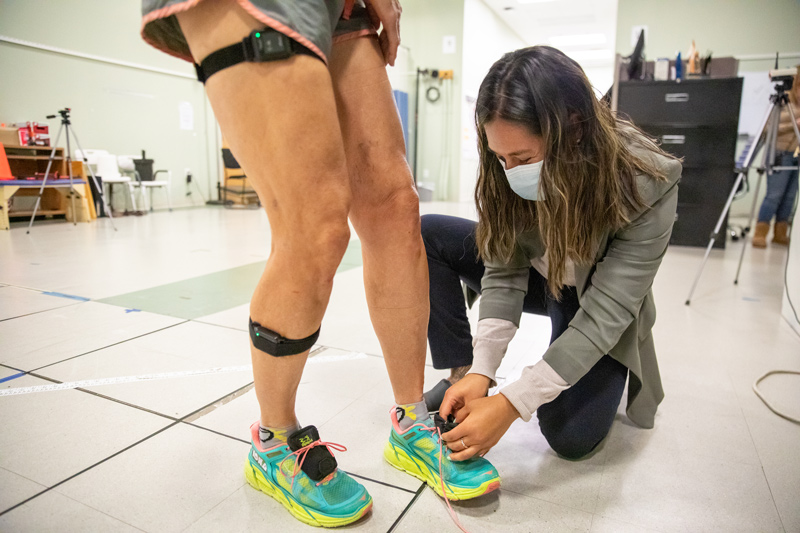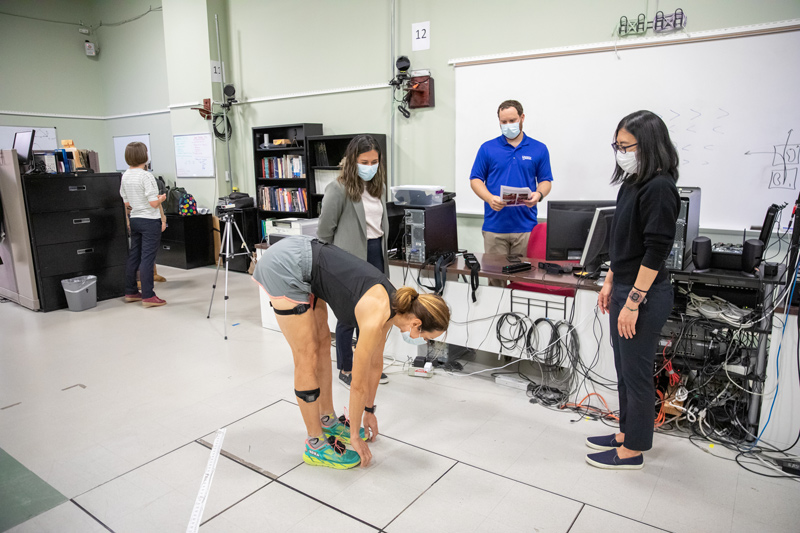


Learning outside the lab
Photos by Ashley Barnas April 27, 2023
Wearable tech helps UD biomechanics researchers get first glimpse at everyday walking patterns
When you walk in a clinical setting, you’re often walking in a straight line and faster than you normally would. It’s because you’re being watched.
“Historically, we’ve gleaned a lot of information from bringing people into the lab and conducting precise measurements, but that information isn’t indicative of their behavior in the real world,” said Jocelyn Hafer.
The assistant professor of kinesiology and applied physiology in the University of Delaware College of Health Sciences is one of the few biomechanists looking to get beyond the well-documented “white coat effect” and gauge gait in people’s everyday lives without a researcher watching over their every move, influencing their behavior.
Using innovative wearable technology and funded through a $434,761 R21 grant from the National Institutes of Health, Hafer will gain a wealth of data about people’s walking patterns and joint ranges of motion.
“Often in the lab, we’ll get 10 strides from a person, and we consider that enough to understand their movements, but they don’t turn, speed up or slow down,” Hafer said. “Using this real-world data, we’ll get thousands of steps for each person, so it’s a much more powerful data set.”
Julien Mihy, doctoral student in biomechanics and movement science (BIOMS), whose past research has focused on running mechanics and injuries, has been working alongside Hafer in the Gait Biomechanics Research Laboratory since the project’s inception.
“I’m very interested in looking at what people do 99% of their life as opposed to the 1% in the lab,” Mihy said. “When people are walking, do they have varying speed? Are people doing stairs? How are they getting out of cars, and what does that look like? Those are questions we’re seeking answers to because we need to have a better understanding of their movements if we want to improve certain tasks.”
Study participants will wear sophisticated sensors, the size of an AppleWatch, on their feet, calves, thighs, and waist over the course of three days and just go about their everyday lives. The sensors are equipped with accelerometers, gyroscopes and magnetometers that will calculate segment motions and joint excursions.
“Previous research with sensors on the foot show steps and speed, but measuring movement at the joint level is much more challenging, so we’re trying to add to that body of knowledge,” Hafer said.

Participants include 30 adults in three categories: the young and healthy aged 21-35; those 55-70 years old with no orthopedic problems, and those 55-70 years old with knee osteoarthritis. She expects certain conditions to be more amplified outside the lab.
“People walk slower, on average, when they’re not in the lab,” Hafer said. “When we look at step or stride length, oftentimes as people get older or as they have increases in orthopedic conditions, their stride length gets shorter, and they take more steps per minute. Shuffling gait is the extreme of that.”
Jennifer Kraut, who’s physically active, was an early volunteer for the study. She’s in the healthy control group.
“I enjoy furthering research,” said Kraut, who plays tennis, cycles, and does weightlifting and yoga.
Kraut was a prime example of the “white coat effect” that researchers like Hafer and Mihy are trying to push past.
“While I was in the lab, I was hyper aware of how I was walking,” Kraut said. “They had me walk at a ‘normal’ rate, and I think my normal pace is quicker. Then, they had me walk at a quicker rate, and I was very aware that I was taking teeny tiny steps to go faster, and I started to feel tight. It wasn’t uncomfortable, but I was aware of how I’m walking, and I usually don’t think about it.”
She said the sensors are barely noticeable.
“I’m only aware of the sensors when I’m changing my shoes,” Kraut said. “They’re more comfortable than a FitBit, and I don’t think wearing them will have any impact on my day.”
Hafer is eager to capture data on participants’ joint movements as they climb stairs and learn how their walking patterns change after they’ve been sedentary for a period and then stand up to walk.
“I want to learn how variable people’s walking patterns are throughout a day and between days,” Hafer said.
Study participants will also get text questionnaires throughout the day asking them about their pain and fatigue levels.
“We expect people will do more in the real-world than they do in the lab, so that adds variability,” Hafer said. “But pain is such a factor in those with knee osteoarthritis, so pain and fatigue will add even more variability to how people are moving. I think that will be really interesting and will give us a wealth of data to explore how pain and fatigue impacts joint health.”
Mihy is excited to correlate the biomechanics data with people’s responses to the questionnaires.
“With knee osteoarthritis, there’s fluctuations in pain and fatigue throughout the day,” Mihy said. “Patients come into a physician’s office when they’re at their best or when they’re in pain, but that doesn’t reflect the other 23 hours of the day. So, understanding how pain and fatigue fluctuates and how that affects a person’s mechanics in a day on a larger scale will help inform clinicians.”
Mihy added being among the first to measure gait outside a lab setting is inspiring.
“It’s amazing,” he said. “But when you’re the first to do it, there’s no baseline, so that’s challenging. But it’s been enjoyable to showcase our research and elaborate on our methods.”
In the future, Hafer hopes to conduct larger longitudinal studies in people with knee osteoarthritis.
“One of the real difficulties is identifying individuals with knee osteoarthritis who will see a faster disease progression,” Hafer said. “Research in labs and clinical studies, thus far, has not been able to identify that.”
Earlier identification of disease progression could promote earlier rehabilitation and interventions. Hafer hopes to see the research progress to a point where knee degeneration could be slowed to prevent osteoarthritis.
“People often don’t go to the doctor until their knee hurts, and by that time, they may already have knee osteoarthritis,” she said. “There could be previously undetectable changes in knee range of motion or changes in the variability of walking patterns day to day that we haven’t quantified yet.”
Hafer said earlier detection of slow declines could help a patient’s prognosis.
“Is the way someone walks in the real world a more sensitive marker of early decline than the way that they walk in the lab?” Hafer asked. “That’s one of many questions we’re trying to answer with this research.
“Imagine if physicians equipped patients with sensors regularly for a few days every year, they could observe data on how people are moving and identify declines before a person’s knee starts to hurt, so a person’s everyday gait and movement could be an early red flag.”
The Gait Biomechanics Research Laboratory is still recruiting participants for this study. Please email gaitbiomechlab@udel.edu for more information.
Contact Us
Have a UDaily story idea?
Contact us at ocm@udel.edu
Members of the press
Contact us at 302-831-NEWS or visit the Media Relations website

